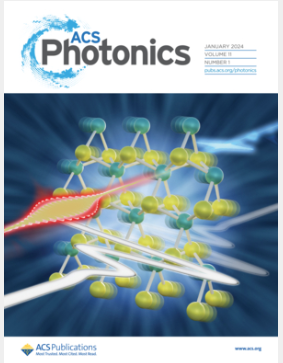Monolithic 960/1000 nm Bicolor Semiconductor Disk Laser Delivers a Brightness of Over 300 MW/cm2sr
IF 6.5
1区 物理与天体物理
Q1 MATERIALS SCIENCE, MULTIDISCIPLINARY
引用次数: 0
Abstract
High-brightness dual-color sources are highly prized in the plethora of nascent applications. Here, we expound upon a new theoretical design and experimental examinations for the attainment of a bicolor semiconductor disk laser. Numerical investigations are conducted in detail, disclosing that the dual-color gain with a separation spanning several tens of nanometers can be actualized via the accurate manipulation of the temperature-dependent quantum wells (QWs) gain-filtering and the disk microcavity-filtering. Employing this strategy, a 960/1000 nm gain chip is engineered. The experimental outcomes evinced that the emission wavelength can be adroitly shifted by governing the pump power or temperature. During the dual-wavelength operation, a near-diffraction-limited power of 3.8 W is procured, the beam quality factor M2 is in the vicinity of 1.1, and the brightness reaches approximately 310 MW/cm2sr. The quasi-continuous wave performances are also appraised under a duty cycle of approximately 10%. A pulse energy of 0.85 mJ and a peak brightness of around 0.75 GW/cm2sr is attained. Moreover, the dual-wavelength stability and synchronization are also corroborated. Overall, these investigative undertakings substantially augment the performance gamut of semiconductor lasers and can be construed as elongation and augmentation of the antecedent works in this discipline.

单片960/1000纳米双色半导体光盘激光器提供超过300 MW/cm2sr的亮度
高亮度双色光源在众多新兴应用中受到高度重视。本文阐述了一种新的双色半导体圆盘激光器的理论设计和实验研究。通过详细的数值研究,揭示了通过精确操纵温度相关的量子阱增益滤波和圆盘微腔滤波,可以实现跨越几十纳米的双色增益。采用该策略,设计了960/ 1000nm增益芯片。实验结果表明,通过调节泵浦功率或泵浦温度,可以巧妙地改变发射波长。双波长工作时,获得近衍射极限功率为3.8 W,光束质量因子M2约为1.1,亮度约为310 MW/cm2sr。在占空比约为10%的情况下,对其准连续波性能进行了评价。脉冲能量为0.85 mJ,峰值亮度约为0.75 GW/cm2sr。此外,双波长稳定性和同步性也得到了证实。总的来说,这些调查工作大大增加了半导体激光器的性能范围,可以解释为延伸和增强在这一学科之前的工作。
本文章由计算机程序翻译,如有差异,请以英文原文为准。
求助全文
约1分钟内获得全文
求助全文
来源期刊

ACS Photonics
NANOSCIENCE & NANOTECHNOLOGY-MATERIALS SCIENCE, MULTIDISCIPLINARY
CiteScore
11.90
自引率
5.70%
发文量
438
审稿时长
2.3 months
期刊介绍:
Published as soon as accepted and summarized in monthly issues, ACS Photonics will publish Research Articles, Letters, Perspectives, and Reviews, to encompass the full scope of published research in this field.
 求助内容:
求助内容: 应助结果提醒方式:
应助结果提醒方式:


